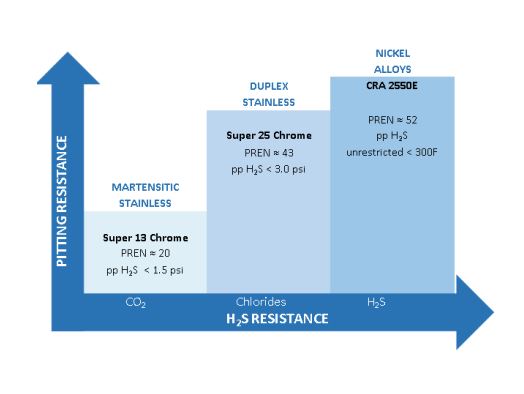H2S corrosion in the presence of tensile stress may result in catastrophic failure as a result of hydrogen embrittlement by mechanisms such as Sulfide Stress Cracking (SSC) and Stress Corrosion Cracking (SCC). Hydrogen embrittlement may also result from other sources of hydrogen such as cathodic protection commonly used in seawater. These failures are often delayed, but happen abruptly with no visible warning and may happen at stresses well below the yield strength. Factors contributing to environmentally assisted cracking (EAC) include partial pressures of H2S and CO2, temperature, pH, chlorides, and stress. Environments with partial pressure of H2S greater than 0.05 psi are considered “sour” and cracking can only be avoided through the proper selection of materials. The potential for an increase in H2S content over the life of the well should be considered. NACE MR0175/ISO 15156 serves as the industry guideline for the selection of materials for sour service.
Material properties contributing to EAC resistance include composition, microstructure, processing history, and hardness. The martensitic stainless steels may be adequate where the partial pressure of H2S is below 1.5 psi and the pH is greater than 3.5 while 25Cr Super Duplex Stainless Steel is acceptable up to 3.0 psi H2S. Above that, nickel-based alloys such as CRA 2550E are required. CRA 2550E can be used up to 300⁰F with no restriction to H2S content. In addition, its high PREN prevents pitting corrosion.


*While every effort has been made to ensure the accuracy of the above review, assessment, conclusions, and report, the appropriateness of their application and their interpretation remain the sole responsibility of the user.
"*" indicates required fields